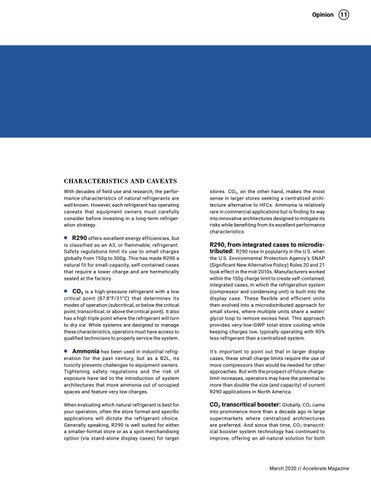Opinion
11
CHARACTERISTICS AND CAVEATS With decades of field use and research, the performance characteristics of natural refrigerants are well known. However, each refrigerant has operating caveats that equipment owners must carefully consider before investing in a long-term refrigeration strategy. R290 offers excellent energy efficiencies, but is classified as an A3, or flammable, refrigerant. Safety regulations limit its use to small charges globally from 150g to 500g. This has made R290 a natural fit for small-capacity, self-contained cases that require a lower charge and are hermetically sealed at the factory.
stores. CO 2 , on the other hand, makes the most sense in larger stores seeking a centralized architecture alternative to HFCs. Ammonia is relatively rare in commercial applications but is finding its way into innovative architectures designed to mitigate its risks while benefiting from its excellent performance characteristics.
R290, from integrated cases to microdistributed: R290 rose in popularity in the U.S. when
CO 2 is a high-pressure refrigerant with a low critical point (87.8°F/31°C) that determines its modes of operation (subcritical, or below the critical point; transcritical, or above the critical point). It also has a high triple point where the refrigerant will turn to dry ice. While systems are designed to manage these characteristics, operators must have access to qualified technicians to properly service the system.
the U.S. Environmental Protection Agency’s SNAP (Significant New Alternative Policy) Rules 20 and 21 took effect in the mid-2010s. Manufacturers worked within the 150g charge limit to create self-contained, integrated cases, in which the refrigeration system (compressor and condensing unit) is built into the display case. These flexible and efficient units then evolved into a microdistributed approach for small stores, where multiple units share a water/ glycol loop to remove excess heat. This approach provides very-low-GWP total-store cooling while keeping charges low, typically operating with 90% less refrigerant than a centralized system.
Ammonia has been used in industrial refrigeration for the past century, but as a B2L, its toxicity presents challenges to equipment owners. Tightening safety regulations and the risk of exposure have led to the introduction of system architectures that move ammonia out of occupied spaces and feature very low charges.
It’s important to point out that in larger display cases, these small charge limits require the use of more compressors than would be needed for other approaches. But with the prospect of future chargelimit increases, operators may have the potential to more than double the size (and capacity) of current R290 applications in North America.
When evaluating which natural refrigerant is best for your operation, often the store format and specific applications will dictate the refrigerant choice. Generally speaking, R290 is well suited for either a smaller-format store or as a spot merchandising option (via stand-alone display cases) for larger
CO 2 transcritical booster: Globally, CO 2 came
into prominence more than a decade ago in large supermarkets where centralized architectures are preferred. And since that time, CO 2 transcritical booster system technology has continued to improve, offering an all-natural solution for both
March 2020 // Accelerate Magazine
